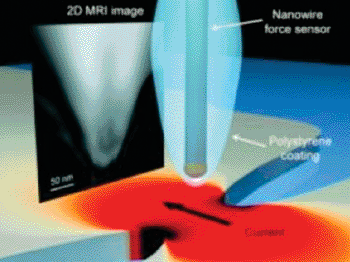New MRI Technology Delivers Nanometer Spatial Resolution
By MedImaging International staff writers
Posted on 08 Oct 2013
Investigators have devised a unique nuclear magnetic resonance imaging (MRI) technique that delivers approximately 10-nm spatial resolutions. Posted on 08 Oct 2013
This represents a significant advance in MRI sensitivity; current MRI techniques typically used in medical imaging generate spatial resolutions on the millimeter scale, with the highest-resolution research devices giving spatial resolution of a few micrometers.

Image: Illustration of the experimental setup shows the two unique components of a novel MRI technique that was successful in producing a 2D MRI image with nanoscale spatial resolution (Photo courtesy of the University of Illinois).
“This is a very promising experimental result,” said the University of Illinois at Urbana-Champaign (U of I; USA) physicist Dr. Raffi Budakian, who led the research group. “Our approach brings MRI one step closer in its eventual progress toward atomic-scale imaging.”
MRI is used widely in clinical practice to differentiate pathologic tissue from normal tissue. It is noninvasive and harmless to the patient, using strong magnetic fields and nonionizing electromagnetic fields in the radiofrequency range, dissimilar to computed tomography (CT) scans and conventional X-rays, which both use more harmful ionizing radiation.
MRI uses static and time-dependent magnetic fields to detect the combined response of large ensembles of nuclear spins from molecules localized within millimeter-scale volumes in the body. Increasing the detection resolution from the millimeter to nanometer range would be a technologic dream come true.
The new technique introduces two novel components to overcome hurdles of applying traditional pulsed MR techniques in nanoscale systems. First, a unique protocol for spin manipulation applies periodic radiofrequency magnetic field pulses to encode temporal correlations in the statistical polarization of nuclear spins in the sample. Second, a nanoscale metal constriction focuses current, generating intense magnetic field-pulses.
In their proof-of-principal demonstration, the team used an ultrasensitive magnetic resonance sensor based on a silicon nanowire oscillator to reconstruct a two-dimensional projection image of the proton density in a polystyrene sample at nanoscale spatial resolution. “We expect this new technique to become a paradigm for nanoscale magnetic-resonance imaging and spectroscopy into the future,” added Dr. Budakian. “It is compatible with and can be incorporated into existing conventional MRI technologies.”
Related Links:
University of Illinois at Urbana-Champaign














